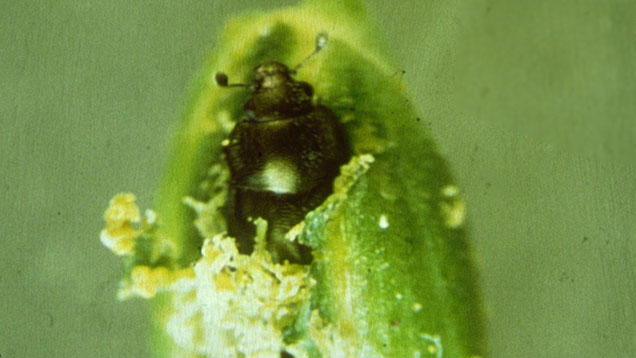Research to eliminate unnecessary pollen beetle sprays

Monitoring data shows that average pollen beetle numbers rarely exceed the five beetles/plant threshold, yet one-fifth of rape growers sprayed their crops in 2012.
It’s a case of a perceived risk and cheap insurance in many situations, says Steve Ellis of Adas. He worries that it may compound insecticide resistance.
“It’s not surprising that many growers are using a pyrethoid insecticide such as lambda-cyhalothrin to control pollen beetle when the science behind spraying thresholds has been questionable.
“We cannot find data to show how thresholds were developed prior to HGCA’s 2013 guidelines.”
See also: Researchers closer to solving top UK barley disease
Measuring the relationship between physiological factors and pollen beetle damage has shown there is inherent crop tolerance in the form of excess buds/flowers which are not needed to achieve potential yield.
These buds can be sacrificed to pollen beetle, he suggests.
Scientists know that the number of excess flowers varies between varieties and season.
However, there is an inverse relationship between plant numbers and the number of excess flowers, so measuring plant populations gives a good estimate of a crop’s tolerance to pollen beetle.
There’s a simple way to measure plant populations, says Dr Ellis.
Research reasons
This project should improve risk assessment of pollen beetle in oilseed rape by better understanding thresholds for treatment in a wide range of situations.
Project: Validation of an integrated pest management (IPM) strategy for pollen beetle to minimise the development of insecticide resistance
Timescale: August 2013 – December 2016
Researchers involved: Adas and Rothamsted Research
Funders: HGCA and Oecos (in kind)
Cost: £120,000 from HGCA
Key points
- Previous spraying thresholds had dubious scientific provenance
- Removing all buds from main stem didn’t reduce crop yield in beetle damage simulation trials last season
- Pigeon damaged crops thought to be no less able to tolerate pollen beetle attacks than ungrazed crop
Stand in the field with your heels together and your feet at right angles and count the number of plant stems inside your foot-framed square, then multiply that by 11 for the estimated number/sq m.
Then using the HGCA’s table, you should calculate the number of beetles needed to destroy the excess flowers, or the threshold for that crop.
Pigeon effect
The project aims to answer two further questions about risk: if the main stem is removed, will that have a greater effect on yield than damage to the side branches, and if the crop has been attacked by pigeons, does that make it more susceptible to beetle damage?
Dr Ellis has established trials to validate thresholds under those circumstances, using mowing to simulate pigeon damage and pruning of buds to simulate beetle feeding.
So far pruning has had no effect on yield and there is no interaction between the mowing and pruning, inferring that the pigeon-damaged crops are no less able to tolerate beetle attacks.
“We are quite surprised, pleasantly so, by the first season’s results.
“They would, if confirmed over two more years, allow growers to have confidence in the current threshold and perhaps save on insecticides. That would reduce resistance build-up.”
Within the project, Sam Cook from Rothamsted Research is assessing how Oecos pollen beetle monitoring traps can help monitor the need to spray.
“We are trying to calibrate traps used to detect when beetles are on the move in large numbers for individual field use, to help detect breaches of threshold populations.”
She is also assessing an online decision support tool to focus monitoring effort to when it is most needed.
The “Pollen Beetle Predictor”, available free of charge from the Bayer Cropscience and HGCA websites, predicts the start, the main peaks and the completion of beetle migration (get ready, monitor and too late to worry, respectively).
Last year, six sites were assessed and Dr Cook was impressed by the accuracy of the predictions. By autumn 2016, growers should have full guidelines on how best to monitor numbers, to modify spraying practices, she hopes.
For more info on pollen beetle thresholds, visit the HGCA website
Volunteers wanted: if you have easy access to an oilseed rape crop and can monitor crops and check a trap about three times a week, please get in touch with Rothamsted Research (all materials are provided).
HGCA perspective by Caroline Nicholls
Research and knowledge transfer manager, HGCA
“Spray treatment thresholds are crucial to managing resistance to pyrethroid insecticides in pollen beetle. In 2013, HGCA issued revised thresholds based on the maximum number of buds each beetle can destroy and the number of excess flowers produced.
“Previous HGCA-funded work showed that plants in crops with lower plant populations produce more branches and thus more flowers, making them more tolerant of pollen beetle. This project seeks to refine and further improve confidence in spray thresholds.”

